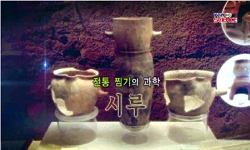The collection of archaeological discoveries presented in A Report on the Excavation of the Mado Underwater Archaeological Site, published by the National Research Institute of Maritime Cultural Heritage, includes three plantbased artifacts from the G...
http://chineseinput.net/에서 pinyin(병음)방식으로 중국어를 변환할 수 있습니다.
변환된 중국어를 복사하여 사용하시면 됩니다.
- 中文 을 입력하시려면 zhongwen을 입력하시고 space를누르시면됩니다.
- 北京 을 입력하시려면 beijing을 입력하시고 space를 누르시면 됩니다.

태안 마도 해역 출수 ‘시루밑’의 복원적 고찰 = A Study on the Restoration of the ‘Steamer Underlay’ Recovered from the Seas off Mado Island, Taean
한글로보기https://www.riss.kr/link?id=A108168424
-
저자
김지현 (동국대학교)

- 발행기관
- 학술지명
- 권호사항
-
발행연도
2022
-
작성언어
Korean
-
주제어
Steamer (siru) underlay ; steamer (siru) ; Mado Island in Taean ; straw & grass craft ; Ombeonggeoji. ; 시루밑 ; 시루 ; 태안 마도 ; 짚풀공예 ; 옴벙거지.
-
등재정보
KCI등재
-
자료형태
학술저널
-
수록면
227-258(32쪽)
-
KCI 피인용횟수
0
- 제공처
- 소장기관
-
0
상세조회 -
0
다운로드
부가정보
다국어 초록 (Multilingual Abstract)
The collection of archaeological discoveries presented in A Report on the Excavation of the Mado Underwater Archaeological Site, published by the National Research Institute of Maritime Cultural Heritage, includes three plantbased artifacts from the Goryeo period. All three relics feature the shape of a steamer (siru) underlay, and are named in the report as follows: Steamer Underlay (Mado Shipwreck 1), Fabric Piece (Mado Shipwreck 2), and Knitted Fabric (Mado Shipwreck 3).
The steamer underlay (called a sirumit in Korean) is a type of culinary utensil that was laid on the inner bottom of a ceramic steamer to keep grains or powder from falling through the holes and to evenly spread steam rising from beneath when used to steam cook food. In the past, steamer underlays were made with grass or vine, which was easily found around people's homes. These implements were carefully washed and dried after cooking for future use.
Typically, steamer underlays were made using straw ropes as the cores, interlacing them with separately prepared cords to create the desired form.
Remarkably, however, the steamer underlays discovered at the Mado Underwater Archaeological Site are uniquely different from traditional underlays in terms of the weaving technique used to make them; unfortunately, they have not been preserved in their original condition due to the long period spent underwater. In this study, the main discussion is focused on the effort of the researcher to restore the original structure of steamer underlays used during the Goryeo period based on extant relics from that period.
This study has revealed that the Steamer Underlay found at Mado Shipwreck 1 is unique in that it was made by weaving perennial grass (called “love grass”; gryeong in Korean) with bamboo strips to be used as the cores. Meanwhile, the piece of fabric recovered from Mado Shipwreck 2 was made from sedge. As this object was only a small part of the original relic, a careful comparison with detailed photographs was required to conclude that it is a fragment of a steamer underlay.
The Knitted Fabric of Mado Shipwreck 3 seems more like a cover than the underlay of a steamer. It was elaborately woven and seems to have been finished by combining the separately made knob with the cover.
The first two artifacts, Steamer Underlay and the piece of fabric, are badly damaged, thus yielding little information about the weaving technique used to make them. That is why their reproductions were made using the traditional technique by which the weaving cord is pulled through from the back to the front, whereas the third artifact, Knitted Fabric, which is in comparatively good condition, was made by pulling the cord from the front through to the back and then fastening it to a loop. While there are some differences between the first two artifacts and the third one with respect to the weaving methods and twist directions, all three were made by using the traditional "steamer underlay technique.” A major achievement of this study is that the "steamer underlay technique”, which has been preserved to the present day, was used in the restoration of these Goryeo artifacts recovered from the seas off Mado Island. The study is expected to contribute to the effort to promote research on the traditional weaving techniques used in the production of plant-based artifacts.
동일학술지(권/호) 다른 논문
-
- 국립해양문화재연구소
- 이상우
- 2022
- KCI등재
-
바다의 경계 확장과 의미 변화 연구 - 천승세의 희곡 <만선>에서 소설 <빙등>까지
- 국립해양문화재연구소
- 김태희
- 2022
- KCI등재
-
- 국립해양문화재연구소
- 문선영
- 2022
- KCI등재
-
부산 바다의 영화적 형상화와 그 의미에 관한 연구 - 1950~60년대 <청춘쌍곡선>과 <갯마을>을 중심으로 -
- 국립해양문화재연구소
- 김남석
- 2022
- KCI등재
분석정보
인용정보 인용지수 설명보기
학술지 이력
| 연월일 | 이력구분 | 이력상세 | 등재구분 |
|---|---|---|---|
| 2024 | 평가예정 | 재인증평가 신청대상 (재인증) | |
| 2021-01-01 | 평가 | 등재학술지 선정 (계속평가) |  |
| 2020-01-01 | 평가 | 등재후보학술지 유지 (계속평가) |  |
| 2018-01-01 | 평가 | 등재후보학술지 선정 (신규평가) |  |




 KCI
KCI



